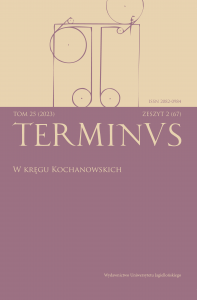Cykl poetycki do Hyelli ze zbioru Lusus Andrei Navagera – wstęp, przekład, komentarz
A poetic cycle on Hyella from Andrea Navagero’s Lusus: introduction, translation, commentary
Author(s): Elżbieta GórkaSubject(s): Polish Literature
Published by: Wydawnictwo Uniwersytetu Jagiellońskiego
Keywords: Andrea Navagero; Lusus; Hyella; erotic poem; lusus pastoralis
Summary/Abstract: The paper presents the first Polish translation of a mini-series of six short poems about Hyella by Andrea Navagero (1483–1529). The selected works are part of Navagero’s famous Latin poetry collection entitled Lusus. The translation is supplemented by an introduction and commentary notes. The Latin text reproduced in the paper is based on the edition of Lusus by Claudio Griggio (2001). The introduction presents the author’s biography and includes a brief description of the whole collection. Navagero was a diplomat, a poet and the official historian of the Republic of Venice. Collected by friends in Orationes duae carminaque nonnulla, his poems were edited posthumously in Venice in 1530. The most important part of Lusus are bucolic epigrams, a new form of Neo-Latin pastoral developed by Navagero. This minor lyric form called “pastoral play” (lusus pastoralis) gained recognition quickly and was widely imitated in 16th century. The collection also includes other literary genres – bucolic poems, elegies, and erotic poems. However, the most famous is the series of epigrams whose heroine or addressee is Hyella, a girl impossible to identify. The introduction presents a discussion about the sources and the interpretation of the love poems about Hyella (poems 21, 22, 28, 31, 32 and 37). The most important literary tradition from which Navagero draws inspiration is the Greek and Latin ancient epigram. For poem 21, the source is the Anacreontea 19, while poem 22 uses the motifs of the lamp and the night as the guardians of lovers, both popular in The Greek Anthology. For two other pieces, the direct source is the poetry of Catullus: poem 31 uses Catullus’s carmen 5, while poem 32 combines motifs from Catullus’s carmina 82, 92 and 109. In addition, in poem 28 we find similarities with Ausonius’s epigram 9. Other important sources for Navagero were the poetry of Petrarch and the neo-Catullan poets, mostly Giovanni Pontano, Michele Marullo, and Cristoforo Landino.
Journal: TERMINUS
- Issue Year: 25/2023
- Issue No: 2 (67)
- Page Range: 243-265
- Page Count: 23
- Language: Polish

